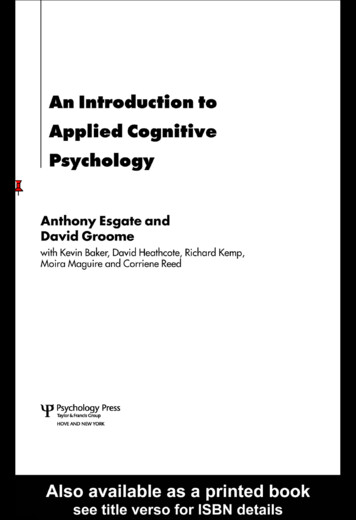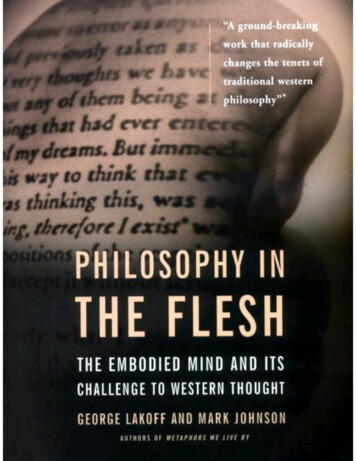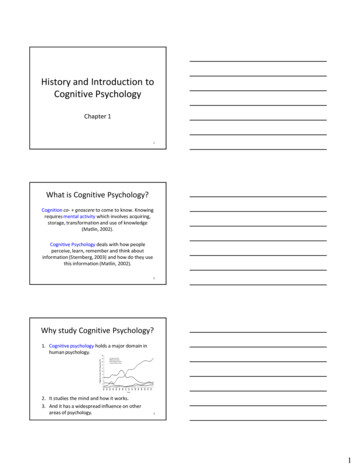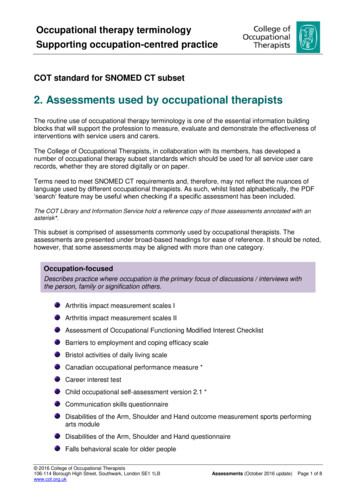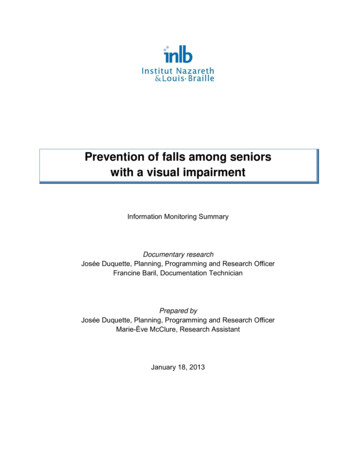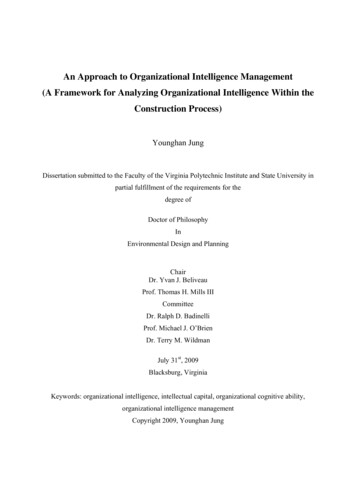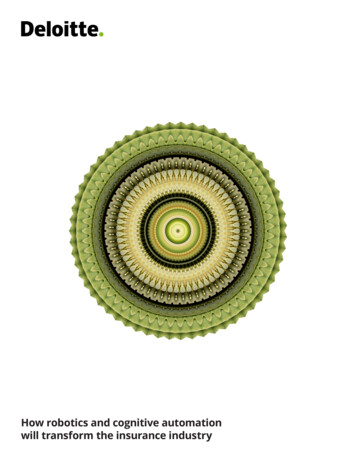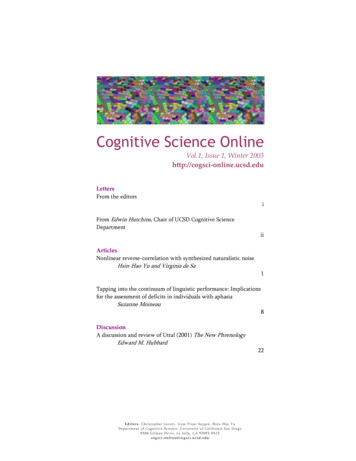
Transcription
Cognitive Science OnlineVol.1, Issue 1, Winter 2003http://cogsci-online.ucsd.eduLettersFrom the editorsiFrom Edwin Hutchins, Chair of UCSD Cognitive ScienceDepartmentiiArticlesNonlinear reverse-correlation with synthesized naturalistic noiseHsin-Hao Yu and Virginia de Sa1Tapping into the continuum of linguistic performance: Implicationsfor the assessment of deficits in individuals with aphasiaSuzanne Moineau8DiscussionA discussion and review of Uttal (2001) The New PhrenologyEdward M. Hubbard22E dito rs: C h r i s t o p h e r L o v e t t , A y ş e Pı nar Say g ı n , Hs i n - Hao YuDe partm e n t o f C o gn i t iv e Sci e n ce , U niv e rs i ty o f C al i fo rn ia San Di e g o9500 Gilman Drive, La Jolla, CA 92093-0515cogsci-online@cog sci.u csd.edu
InformationCognitive Science Online is an online journal published by the UCSD Cognitive ScienceDepartment and seeks to provide a medium for the cognitive science community in which toexchange ideas, theories, information, advice and current research findings. This onlinepublication is a peer-reviewed and highly interdisciplinary academic journal seekingcontributions from all disciplines and methodologies investigating the mind, cognition andtheir manifestation in living, and possibly artificial, systems. For more information about thisjournal, submissions, back issues, please visit our website at http://cogsci-online.ucsd.eduContact InformationDepartment of Cognitive ScienceUniversity of California San Diego9500 Gilman DriveLa Jolla, CA stopher LovettAyşe Pınar SaygınHsin-Hao YuAdvisory Editorial BoardF. Ackerman, LinguisticsE. Bates, Cognitive ScienceP.S. Churchland, PhilosophyM. Cole, Communication and PsychologyS. Coulson, Cognitive ScienceG. Cottrell, Computer ScienceR. D’Andrade, AnthropologyV.R. de Sa, Cognitive ScienceD. Deutsch, PsychologyK. Dobkins, PsychologyK. Emmorey, Salk InstituteY. Engeström, CommunicationV. Ferreira, PsychologyS. Hillyard, NeurosciencesJ. Hollan, Cognitive ScienceE. Hutchins, Cognitive ScienceT-P. Jung, Inst. for Neural Computationand Salk InstituteD. Kirsh, Cognitive ScienceM. Kutas, Cognitive Science andNeurosciencesT-W. Lee, Inst. for Neural ComputationD. MacLeod, PsychologyS. Makeig, Inst. for Neural ComputationG. Mandler, PsychologyJ. Mandler, Cognitive ScienceJ. Moore, AnthropologyR-A. Müller, Psychology (SDSU)D. O’Leary, Salk InstituteD. Perlmutter, LinguisticsM. Polinksky, LinguisticsD.P. Salmon, NeurosciencesM.I. Sereno, Cognitive Science andNeurosciencesL. Squire, Psychiatry and NeurosciencesJ. Triesch, Cognitive ScienceB. Wulfeck, Comm. Disorders (SDSU)
Cognitive Science Online, Vol.1, 2003http://cogsci-online.ucsd.eduLetter from the EditorsWelcome to the first issue of Cognitive Science Online. In creating this journal wehave tried to provide our readers with an insightful and sometimes entertainingglimpse into the world of cognitive science, and whether you are part of thedepartment or interdisciplinary program here at UCSD, a member of the far-reaching,global cognitive science community, or are just curious as to what strange andesoteric research we cognitive scientists have been up to, we're sure you'll be pleasedwith the results. In creating a journal of this kind we felt it particularly crucial torepresent the diversity of ideas floating around in our highly variegated field ofcognitive science, as too often the lines that have traditionally partitioned its subdisciplines begin to form impenetrable barriers around isolated laboratories, and theintegrative perspective can begin to fade if left unchecked. As a medium to keep theinterdisciplinary spirit of cognitive science alive and flourishing, one of this journal'smain aims is to provide a convenient and highly visible forum for communicatinginformation, knowledge and ideas between various researchers and theoreticians whoare devoted to studying and ultimately understanding cognition in all itsinstantiations. Hopefully it will prove to be a valuable resource to those of youwishing to keep abreast of the current research, methodologies, ideas and opinionsmaking up the science of the mind, as well as fostering the incorporation of thisinformation with your own ideas and activities.As graduate students, we are perhaps in the best position to draw and integrateinformation from various laboratories, as well as having the freedom to pushmethodological limits in creating truly novel and creative research designs. In thisjournal we are particularly interested in publishing scholarly papers written bygraduate students in cognitive science or a related field, not only to provide thesestudents with exposure to the outside world, but also to provide examples of the typeof cutting-edge work being done in the spirit of a truly unified cognitive science. Inaddition, this journal provides a forum within which to discuss current opinions andissues, exchange information, facilitate solidarity and cohesion within the department,as well as between various departments within and outside of the UCSD cognitivescience community. We would also like to increase the visibility of the field, thepeople comprised by it, their ideas and their achievements, bringing a greater sense ofwhat cognitive science is and why it is so important to the world at large. Hopefullywe will be successful. Enjoy!Christopher LovettAyşe Pınar SaygınHsin-Hao Yui
Cognitive Science Online, Vol.1, 2003http://cogsci-online.ucsd.eduLetter from Edwin Hutchins, Chair of theCognitive Science DepartmentIt is a pleasure to contribute a note to the inaugural edition of Cognitive ScienceOnline. This peer-reviewed electronic journal edited and produced by the graduatestudents is a great idea for many reasons. Three aspects of the project are especiallyappealing.First, the way the journal project captures and focuses the energy of the department.Cognitive Science is an exciting and rapidly changing field. Our community is aunique group of talented people. One of the best elements of the department chair'sjob is that it brings one into contact with the activities of the entire department. Thechair sees the full scope of the work of the department as reflected in teaching,research proposals, publications, honors, and awards. I can tell you that an enormousamount of groundbreaking work is going on in the department. However, our currentinstitutional practices leave much of that work invisible to the department as a whole.Our second-year project and third-year thesis prospectus presentations are valuable inpart because they bring the diverse work of our graduate students into the public eye.Cognitive Science Online provides a forum for communicating to the entirecommunity not just in the month of June and not just about core projects. The visionof the journal is to encourage the exchange of ideas in this very interdisciplinarycommunity. This seems to me to be exactly right. The emphasis on graduate studentcontributions is also appropriate. Historically, the department's graduate students havesupplied, through their research with multiple mentors, the integration that individualfaculty members could not accomplish. I welcome Cognitive Science Online as acontext in which we can show each other what we do.Second, a journal run by the students fits perfectly with the wider mission of thedepartment. As a department, we have a stewardship relationship to a body ofknowledge. We are responsible for developing the science of the mind throughresearch, passing that knowledge along to another generation of scholars throughteaching, applying that knowledge where it can do good in the world, and defendingthe knowledge against corruption. The interdisciplinary nature of cognitive sciencemakes an in-house journal especially appropriate. To build a department of cognitivescience (singular) rather than cognitive sciences (plural), we must continue to fostercommunication across traditional disciplinary boundaries. The extent to which ourdepartment has achieved and maintained integration across a wide range of domainsand methods is truly remarkable. This is perhaps the single attribute that most clearlydistinguishes this community from other similar efforts. An in-house forum for theopen exchange of ideas is thus perfectly suited to our mission. We are truly fortunateto have students with motivation required to make this project go.Finally, publication is an essential function in our profession. Cognitive ScienceOnline provides graduate students, and others, a convenient early step in a processthat is central to our lives as academics. I hope that everyone will contribute. Theii
Cognitive Science Online, Vol.1, 2003http://cogsci-online.ucsd.eduproject also provides the editors a context for learning essential skills in editing andmanagement of a journal.In retrospect, the journal seems like the obvious thing for the world's best graduateprogram in cognitive science to do. The founding board of editors, ChristopherLovett, Ayşe Pınar Saygın, and Hsin-Hao Yu, deserve our collective thanks fordeveloping the idea and providing the vision and documentation required to get theproject started. Initiative like theirs makes this a department we are happy to come towork in and proud to call our own.Edwin HutchinsChair, UCSD Cognitive Science Departmentiii
Cognitive Science Online, Vol.1, pp.1–7, 2003http://cogsci-online.ucsd.eduNonlinear reverse-correlation withsynthesized naturalistic noiseHsin-Hao YuDepartment of Cognitive ScienceUniversity of California San DiegoLa Jolla, CA 92093hhyu@cogsci.ucsd.eduVirginia R. de SaDepartment of Cognitive ScienceUniversity of California San DiegoLa Jolla, CA on is the most widely used method for mapping receptive fields of early visual neurons. Wiener kernels of the neurons arecalculated by cross-correlating the neuronal responses with a Gaussianwhite noise stimulus. However, Gaussian white noise is an inefficientstimulus for driving higher-level visual neurons. We show that if thestimulus is synthesized by a linear generative model such that its statistics approximate that of natural images, a simple solution for the kernelscan be derived.1IntroductionReverse-correlation (also known as white-noise analysis) is a system analysis technique forquantitatively characterizing the behavior of neurons. The mathematical basis of reversecorrelation is based on the Volterra/Wiener expansion of functionals: If a neuron is modeledas the functional y(t) f (x(t)), where x(t) is the (one dimensional) stimulus to the neuron, any nonlinear f can be expanded by a series of functionals of increasing complexity,just like real-valued functions can be expanded by the Taylor expansion. The parameters inthe terms of the expansion, called kernels, can be calculated by cross-correlating the neuronal responses to the stimulus, provided that the stimulus is Gaussian and white (Wiener,1958; Lee & Schetzen, 1965; Marmarelis & Marmarelis, 1978).Reverse correlation and its variants are widely used to study the receptive field (RF) structures of the sensory systems. In vision, the circular RF’s of LGN neurons and the gabor-likeRF’s of simple cells in the primary visual cortex are revealed by calculating the first-order(linear) kernels. Neurons with more nonlinearity, such as complex cells, can also be studiedby the second-order kernels (Szulborski & Palmer, 1990). However, reverse correlation israrely applied to extrastriate visual areas, such as V2. One of the many factors that limitreverse correlation to the study of the early visual system is that Gaussian white noise is aninefficient stimulus for driving higher order neurons, since visual features that are knownto activate these areas (Gallant et al., 1996; Hegdé & Van Essen, 2000) appear very rarelyin Gaussian white noise.
Cognitive Science Online, Vol.1, 20032The goal of this paper is to show that if we generate more “interesting” stimuli by traininga linear generative model from natural images, solutions to the kernels can be obtainedeasily. We will proceed by first formulating the Volterra/Wiener series, describe the lineargenerative model of stimulus synthesis, derive the kernels, and then compare this schemeto other reverse-correlation methods using natural stimuli. The design of physiologicalexperiments using this stimulus is in progress.2The Wiener series and reverse correlationFor simplicity, we will only consider systems of two inputs: y(t) f (x1 (t), x2 (t)).Systems of more than two inputs (that is, driven by a stimulus of more than two pixels)follow the same mathematical form.The Volterra series of f is given by:y(t) f (x1 (t), x2 (t)) V0 V 1 V 2 . . .V0 k1 k2ZZV1 k1 (τ )x1 (t τ )dτ k2 (τ )x2 (t τ )dτZZV2 k11 (τ1 , τ2 )x1 (t τ1 )x1 (t τ2 )dτ1 τ2ZZ k22 (τ1 , τ2 )x2 (t τ1 )x2 (t τ2 )dτ1 τ2ZZ k12 (τ1 , τ2 )x1 (t τ1 )x2 (t τ2 )dτ1 τ2V0 is the constant term. V1 describes the linear behavior of the system. The kernels k1 (τ )and k2 (τ ) are called the first-order kernels. V2 describes the nonlinearity involving interactions between the two inputs. The kernels in V2 are called the second-order kernels. Thereis a second-order kernel for each pair of inputs. k11 (τ1 , τ2 ) and k22 (τ1 , τ2 ) are called theself kernels and k12 (τ1 , τ2 ) is called the cross kernel.In order to solve for the kernels, Wiener re-arranged the Volterra series such that the termsare orthogonal (uncorrelated) to each other, with respect to Gaussian white inputs (Wiener,1958; Marmarelis & Naka, 1974; Marmarelis & Marmarelis, 1978).y(t) f (x1 (t), x2 (t)) G0 G1 G2 . . .G 0 h1 h2ZZG1 h1 (τ )x1 (t τ )dτ h2 (τ )x2 (t τ )dτZZZG2 h11 (τ1 , τ2 )x1 (t τ1 )x1 (t τ2 )dτ1 τ2 P h11 (τ, τ )dτZZZ h22 (τ1 , τ2 )x2 (t τ1 )x2 (t τ2 )dτ1 τ2 P h22 (τ, τ )dτZZ h12 (τ1 , τ2 )x1 (t τ1 )x2 (t τ2 )dτ1 τ2
Cognitive Science Online, Vol.1, 20033Figure 1: The stimuli (vector x, upper row) are synthesized by linearly transforming awhite noise cause (vector s, lower row) via a linear generative model: x A s. Matrix Ais learned from samples of natural images.where x1 (t) and x2 (t) are independent Gaussian white inputs, with equal power (or variance) P . The kernels are called the Wiener kernels.Lee and Schetzen (Lee & Schetzen, 1965) showed that the Wiener kernels can be calculatedby cross-correlating the neuronal response y(t) with the inputs. For example, the firstorder kernel h1 (τ ) can be calculated from hy(t)x1 (t τ )i, self-kernel h11 (τ1 , τ2 ) fromhy(t)x1 (t τ1 )x1 (t τ2 )i, and the cross-kernel h12 (τ1 , τ2 ) from hy(t)t1 (y τ1 )x2 (t τ2 )i1 .See (Marmarelis & Naka, 1974; Marmarelis & Marmarelis, 1978) for details.3Synthesis of naturalistic noise and kernel calculation3.1The synthesis modelInstead of using Gaussian white noise for reverse correlation, we can linearly transformwhite noise such that the the statistics of the transformed images approximate those ofnatural images. This should produce a better stimulus for higher-order visual neurons sinceit contains more features found in nature.More specifically, let the stimulus x(t) (x1 (t) . . . xn (t))T be synthesized by:x(t) A s(t) "x1 (t) . .xn (t)#A s1 (t) . . sn (t)where s(t) (s1 (t) . . . sn (t))T is white. The vector s(t) is called the cause of the stimulusx(t). The constant matrix A can be learned from patches of natural images by various algorithms, for example, Infomax Independent Component Analysis (Infomax ICA) (Bell &Sejnowski, 1995, 1996). In this case, the causes s1 (t) . . . sn (t) are required to be Laplaciandistributed.1h i denotes expectation over t
Cognitive Science Online, Vol.1, 20034Examples of the synthesized stimuli are illustrated in Figure 1. Visual features that occurvery rarely in white noise, such as localized edges, corners, curves, and sometimes closedcontours, are much more common after the A transformation.Using linear generative models to synthesize stimulis for physiological experiments wasalso suggested in (Olshausen, 2001).3.2Kernel calculationTo calculate the kernels, one can follow Wiener and orthogonalize the Volterra series withrespect to the distribution of the new stimulus, instead of Gaussian white noise. Here weprovide a much simpler solution, using a trick that is similar to the treatment of non-whiteinputs in (Lee & Schetzen, 1965).The derivation is illustrated in Figure 2. Instead of directly solving for the kernels ofsystem f , we consider system f 0 , which is formed by combining system f with the lineargenerative model: f 0 f A (Figure 1b). The kernels of system f 0 can be calculated by thestandard cross-correlation method, because its input s(t) is white2 . After f 0 is identified,we consider a new system f 00 , formed by combining f 0 with the inverse of the generativemodel: f 00 f 0 A 1 (Figure 1c). The kernels of system f 00 can be easily obtained byplugging s(t) A 1 x(t) into the kernels of f 0 , and expressing the kernels as functions ofx(t) instead of s(t). But since f 00 f 0 A 1 f A A 1 f , system f 00 is equivalentto f . We therefore calculate kernels of f by transforming the kernels of f 0 .s(t)fAy(a)s(t)Afy(b)f'x(t)A-1f'y(c)f'' fFigure 2: The derivation of formulas for kernels. (a) In order to calculate the kernels ofsystem f , we form the system f 0 as in (b). Kernels of system f 0 can be obtained by thestandard cross-correlation method because the input s is white. After the kernels of f 0 areidentified, we construct system f 00 as in (c). The kernels of system f 00 can be obtained bytransforming the kernels of f 0 . But since f 00 is equivalent to f , this yields the kernels thatwe wanted in the first place.2Note that s(t) is Laplacian distributed, instead of Gaussian distributed. Kernels higher than thefirst order need to be calculated according to (Klein & Yasui, 1979; Klein, 1987).
Cognitive Science Online, Vol.1, 20035Let φ1 (τ ) . . . φn (τ ) be the first-order kernels of f 0 , obtained by cross-correlating systemresponse with white noise s(t). The first-order kernels of the original system f , h1 (τ ). . . h2 (τ ), are simply h1 (τ )φ1 (τ ) . t A .hn (τ )φn (τ )The second-order kernels of system f ,hij (τ1 , τ2 ),i, j 1 . . . n,hij (τ1 , τ2 ) hji (τ1 , τ2 )can be calculated from φij (τ1 , τ2 ), kernels of system f 0 , by the following equation: c11 h11 (τ1 , τ2 ) . . . . .cn1 hn1 (τ1 , τ2 ) . . . c1n h1n (τ1 , τ2 )c11 φ11 (τ1 , τ2 ) . . . . t A .cnn hnn (τ1 , τ2 )cn1 φn1 (τ1 , τ2 ) . . .where cij 1 if i j, and cij 3.312 c1n φ1n (τ1 , τ2 ) 1. A.cnn φnn (τ1 , τ2 )if i 6 j. Higher order kernels can also be derived.Notes on implementationFirst, since training ICA on natural images usually produces a matrix whose row vectorsresemble gabor functions(Bell & Sejnowski, 1996), we can construct matrix A directly asrows of gabor patches. This is similar to the synthesis model in (Field, 1994), and has theadvantage of not being biased by the particular set of images used for training. From thispoint of view, the synthesized stimulus is a random mixture of edges.Second, the synthesis method described so far generates each frame independently. If ICAis trained on movies, we can synthesize image sequences with realistic motion (van Hateren& Ruderman, 1998; Olshausen, 2001). The frames in the sequences are correlated, butdescribed by independent coefficients. The spatiotemporal kernels of neurons with respectto synthesized movies can also be derived by the same procedure.4Comparison to related workTo overcome the limitations of using Gaussian white noise for reverse correlation, researchers have recently started to use natural stimuli (Theunissen et al. (2000) in the auditory domain, and Ringach et al. (2002) in vision). They found RF features that were notrevealed by white noise. The analysis strategy of these methods is to model receptive fieldsas linears filter with zero memory, and solve for the mean square error solution by regression (DiCarlo et al., 1998) or the recursive least square algorithm (Ringach et al., 2002).This involves estimating and inverting the spatial autocorrelation matrix of the stimulus.The advantages of our approach using synthesized stimulus are: Dealing with natural images usually requires a large amount of memory and storage. In our method, unlimited number of frames can be generated on demand,once the synthesis matrix A is learned. Kernel calculation is also easier. In our method, all the statistics about the stimulus is contained in the matrix A,allowing us to formulate reverse correlation in terms of the Wiener series andderive formulas for higher order kernels, which can be important for studying the
Cognitive Science Online, Vol.1, 20036non-linear behavior of neurons (Szulborski & Palmer, 1990). Higher order kernelsfor natural images are much more difficult to derive, due to their complicated (andlargely unknown) statistical structure. The existing regression methods for naturalimage reverse correlation assume linearity and do not allow the calculation ofhigher order kernels. The synthesis model is motivated by the redundancy reduction theory of the earlyvisual code (Barlow, 1961; Field, 1994; Olshausen & Field, 1996; Bell & Sejnowski, 1996), which states that the goal of early visual code is to transform theretinal representations of natural images to an independent, sparse code. If thistheory is to be taken literally, the computation of the early visual system is essentially A 1 , and the synthesized stimulus x(t) is represented as s(t) by the firstorder system (the primary visual cortex). Under this assumption, second-orderneurons are receiving (Laplacian distributed) white noise stimuli. The kernels φ’scan therefore be interpreted as the kernels of higher-order systems with respectto cortical codes, instead of retinal codes. This can be useful for interpreting thenon-linear behavior of neurons(Hyvärinen & Hoyer, 2000; Hoyer & Hyvärinen,2002)5DiscussionWe have shown how to easily derive kernels for a specific form of naturalistic noise. As thisstimulus has more of the features of natural stimulation, it should more strongly activatevisual neurons and allow us to more efficiently explore receptive fields.We are currently designing physiological experiments to test this procedure on simple andcomplex cells in the primary visual cortex of squirrels. Specifically, We will calculate first-order kernels using white noise, synthesized naturalisticnoise, and natural images, and compare the quality of the receptive field maps. Examine if second-order kernels can be reliably calculated, and see if they help topredict the behavior of neurons. Analyze the relationship between h’s (kernels with respect to retinal code) andφ’s (kernels with respect to cortical code, under the whitening hypothesis), andexamine if the coding hypothesis helps us understand the structure of the complexcells.ReferencesBarlow, H. B. (1961). The coding of sensory messages. In Current problems in animalbehavior. Cambridge: Cambridge University Press.Bell, A. J., & Sejnowski, T. J. (1995). An information maximisation approach to blindseparation and blind deconvolution. Neural Computation, 7(6), 1129–1159.Bell, A. J., & Sejnowski, T. J. (1996). Edges are the “independent components” of naturalscenes. Advances in Neural Information Processing Systems, 9.DiCarlo, J. J., Johnson, K. O., & Hsiao, S. S. (1998). Structure of receptive fields in area3b of primary somatosensory cortex in the alert monkey. Journal of Neuroscience,18, 2626–2645.Field, D. J. (1994). What is the goal of sensory coding. Neural Computation, 6(4), 559–601.
Cognitive Science Online, Vol.1, 20037Gallant, J. L., Connor, C. E., Rakshit, S., Lewis, J. E., & Van Essen, D. C. (1996). Neuralresponses to polar, hyperbolic, and cartesian gratings in area V4 of the macaquemonkey. Journal of Neurophysiology, 76, 2718–2739.Hegdé, J., & Van Essen, D. (2000). Selectivity for complex shapes in primate visual areav2. The Journal of Neuroscience, 20(RGB 1 of 8).Hoyer, P. O., & Hyvärinen, A. (2002). A multi-layer sparse coding network learns contourcoding from natural images. Vision Research, 42(12), 1593-1605.Hyvärinen, A., & Hoyer, P. O. (2000). Emergence of phase and shift invariant features bydecomposition of natural images into independent feature subspaces. Neural Computation, 12(7), 1705-1720.Klein, S. A. (1987). Relationship between kernels measured with different stimuli. In P. Z.Marmarelis (Ed.), Advanced methods of physiological system modeling (Vol. I, pp.278–288). Plenum Press.Klein, S. A., & Yasui, S. (1979). Nonlinear systems analysis with non-gaussian whitestimuli: general basis functionals and kernels. IEEE Transactions on InformationTheory, IT-25(4).Lee, Y. W., & Schetzen, M. (1965). Measurement of the wiener kernels of a non-linearsystem by cross-correlation. International Journal of Control(2), 234–254.Marmarelis, P. Z., & Marmarelis, V. Z. (1978). Analysis of physiological systems: thewhite noise approach. Plenum Press.Marmarelis, P. Z., & Naka, K. (1974). Identification of multi-input biological systems.IEEE Transactions on Biomedical Engineering, BME–21(2).Olshausen, B. A. (2001). Sparse coding of time-varying natural images. In Society forneuroscience abstracts (Vol. 27). Society for Neuroscience.Olshausen, B. A., & Field, D. J. (1996). Emergence of simple-cell receptive field propertiesby learning a sparse code for natural images. Nature, 381, 607–609.Ringach, D. L., Hawken, M. J., & Shapley, R. (2002). Receptive field structure of neurons in monkey primary visual cortex revealed by stimulation with natural imagesequences. Journal of Vision, 2(1), 12-24.Szulborski, R. G., & Palmer, L. A. (1990). The two-dimensional spatial structure ofnonlinear subunits in the receptive fields of complex cells. Vision Research, 30(2),249–254.Theunissen, F. E., Sen, K., & Doupe, A. J. (2000). Spectral-temporal receptive fields ofnonlinear auditory neurons obtained using natural sounds. The Journal of Neuroscience, 20(6), 2315-2331.van Hateren, J. H., & Ruderman, D. L. (1998). Independent component analysis of image sequences yields spatio-temporal filters similar to simple cells in primary visualcortex. Proc.R.Soc.Lond. B(265), 2315–2320.Wiener, N. (1958). Nonlinear problems in random theory. The M.I.T. Press.
Cognitive Science Online, Vol.1, pp.8-21, 2003http://cogsci-online.ucsd.eduTapping into the continuum of linguisticperformance: Implications for the assessment ofdeficits in individuals with aphasiaSuzanne MoineauJoint Doctoral Program in Language and Communicative DisordersUniversity of California San Diego andSan Diego State Universitysmoineau@crl.ucsd.eduAbstractThe fundamental goal of every speech and language clinician is toprovide services that will enhance the functional communicativeabilities of the patients they treat. The cornerstone of developing asuccessful intervention program is careful patient assessment.Historically, clinicians have relied on traditional standardizedlanguage and neuropsychological assessment tools to determineperformance baselines from which to plan the treatment course.Although informative in many ways, the batteries that are used canalso be limiting. Most often they force clinicians and researchers intoforming categorical diagnostic groups, which may result in the loss ofcritical information essential for the planning of therapeuticinterventions. The purpose of the current paper is to review someempirical evidence that suggests we should strongly considerredefining classic syndromes, redesigning standard assessment tools,and utilizing new technologies to map out the symptom space inindividuals with brain injury.IntroductionIn 1861, Paul Broca published an historically influential paper that aimed tosystematically map behavioral symptoms to particular brain regions. Specifically,Broca claimed that the third convolution of the left frontal lobe was the seat ofarticulate speech, and that damage to this area would result in a defect in the motorrealization of language (Goodglass, 1993). Soon after, Broca’s aphasia becamewidely accepted as an impairment in the production of language resulting in a patienthaving non-fluent speech output but intact auditory comprehension. The patient thusexhibits an apparent ability to fully understand directives, questions and even simpleconversation despite speech production that is telegraphic, primarily consisting ofcontent words, and noticeably labored. Although the last 40 years have brought aboutminor revisions in this classic definition (i.e., auditory comprehension deficits can beseen, but only with complex syntax and grammar (Grodzinsky, 1995, 2000)), the coreof the classification remains unchanged. Likewise, the cognitive and behavioral
Cognitive Science Online, Vol.1, 20039deficits associated with left temporal lobe damage, as outlined by Carl Wernicke,have undergone very little, if any, revision since 1874. Damage to this area of thebrain typically results in deficits in comprehension of spoken language, however, asnon-speech sensory images are purportedly intact, the Wernicke’s aphasicdemonstrates fluent, albeit paraphasic speech output. A patient with this classicprofile typically suffers from an inability to comprehend even the simplest oflinguistic stimuli (e.g., ‘Is your name Bob?’ or ‘Touch your nose’). Also, despitehaving the natural flow and contours of normal speech production, the Wernicke’saphasic frequently produces non-words or misuses words in a given context. Thoughcurrent diagnostic categories are grossly sufficient in describing the prototypicalsyndrome characteristics, a vast number of individuals with aphasia do not ‘fit’ theseprototypes. This early observation fueled numerous debates, which continue to thisday, about the nature of brain organization for language producti
Cognitive Science Online is an online journal published by the UCSD Cognitive Science Department and seeks to provide a medium for the cognitive science community in which to exchange ideas, theories, information, advice and current research findings. This online publication is a peer-revie
